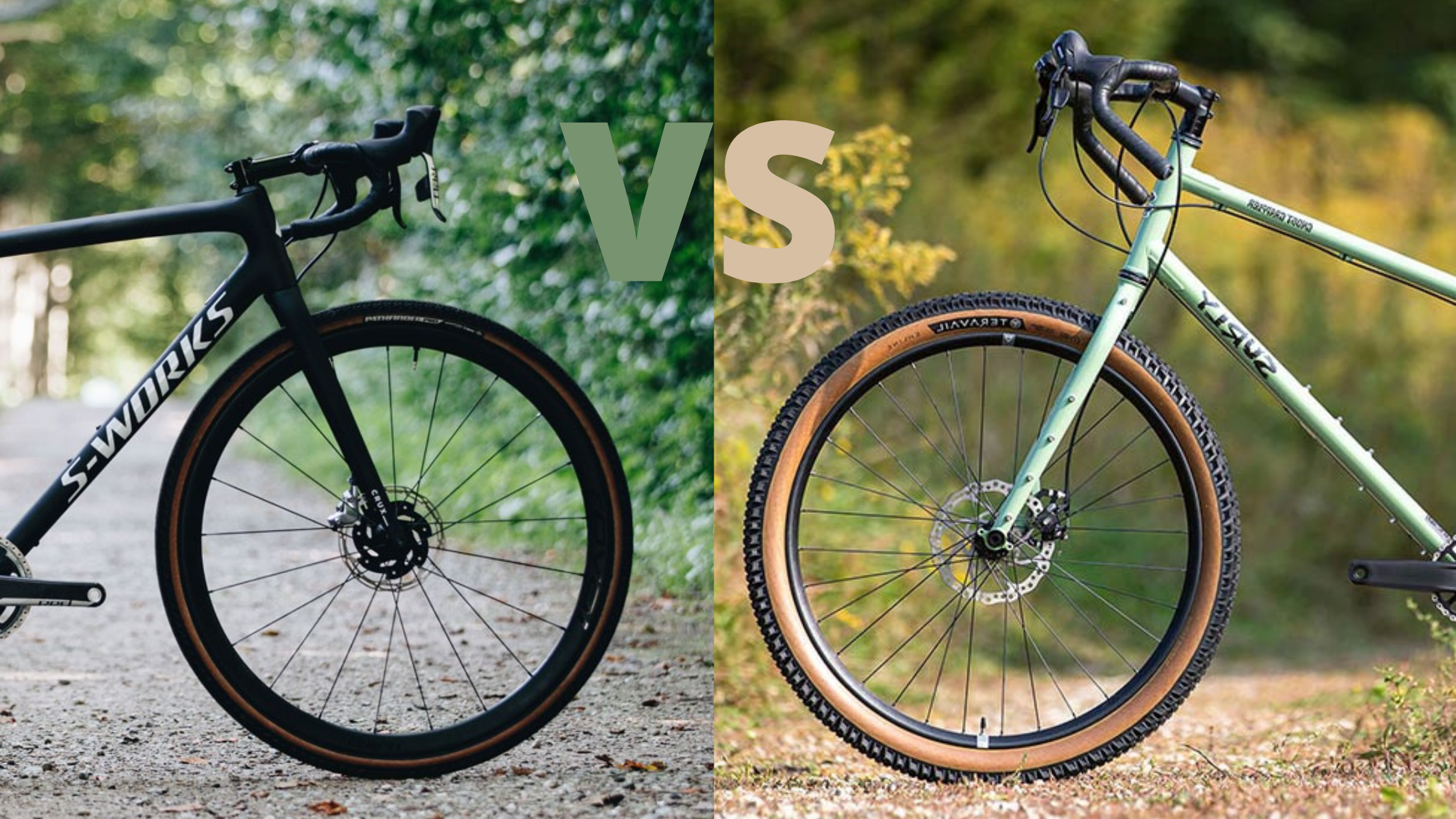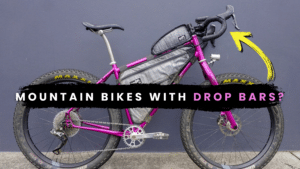What really is the difference between the two? Is it just marketing hype? Maybe you are new to the gravel scene and haven’t even heard of a drop bar mountain bike.
What are drop bar MTB’s?
Drop bar mountain bikes fit somewhere between gravel bikes and a mountain bikes. Put simply they are essentially gravel bikes with larger tire clearance and more mountain bike focused geometry. They often have tire clearance of 2.1″ or wider. Giving you the ability to run 29er wheels! The above link is a list of some drop bar mountain bikes.
What are gravel bikes?
For the purpose of comparison we will touch on what a gravel bike is. You probably already have a base understanding. Simply put they are a good mashup between a road bike and cyclocross bike. Essentially a road bike with more relaxed geometry (not in all cases) allowing you to explore those less travelled dirt roads.
However the gravel bike scene is seeing much more innovation and improvement meaning the term gravel bike is synonyms with bikes that are more lended to all-road racing to epic off-road bikepacking adventures. Some only offer tire clearance for 35mm tires while others can fit juicy 2.4″ tires or sometimes even wider.
Gravel Bike Vs Drop Bar MTB Geometry

Steering (Gravel Bike vs Drop Bar MTB)
When it comes to steering there are generally three different types of measurements that we use to identify how a bike steers. Head Tube Angle, Fork Rake (or Offset) and Fork Trail.
When we take a look at the comparison table above we can see that all the drop bar mountain bikes have slacker head tube angles. All at around 69 degrees compared to an average 72 degrees for the gravel bike examples.
Which means slower steering and more effort is required to steer. Generally though mountain bikes head tube angles can range anywhere from 62 degrees (slack) to 73 degrees (steep). The Slacker head tube angle on Drop Bar mtb’s also make the bike feel more stable. With the wheel pushed further out in front of your centre-mass, it adds confidence when riding down steep technical sections making it harder to go over the handlebars.
In comparison with gravel bikes they generally have steeper head tube angels which makes for faster steering and less effort required to steer the bike.
When looking at fork rake, increasing the rake the faster the steering and shorter rake means slower steering. However there is more to steering than just rake so its not recommended to just base how a bike steers of just the rake measurement.
However looking at the examples above you can see that the rake measurement is all over the board.
Head tube angle and rake combined is what we call the trail. This is often the best way to see how a bikes steering is. You can clearly see that drop bar mountain bikes have more trail (78 average trail) which means slower steering than the gravel bike examples. Which makes them more stable than gravel bikes. While the gravel bikes have less trail and offer faster steering (62 average trail).
Drop bar mountain bikes feel more stable like you are steering from the hips with more leaning. While most gravel bikes feel more nimble like you’re steering with your hands.
Also having more trail means drop bar mtb’s handle much better with wider bars. If you wish to run 50mm or wider drop bars you get greater steering leverage and therefore requires less steering input when turning.
It’s important to note that most gravel bikes are actually good for most bikepacking adventures. Its just that drop bar mtb’s are much more superior when it comes to steering. Especially if you are after a truely capable bike for off-road cycling adventures.
Chainstay & Wheelbase Length (Gravel Bike vs Drop Bar MTB)
Drop Bar Mountain bikes have longer chainstays and wheelbase lengths when compared to gravel bikes. (Approx 445 mm average compared to 427 mm for the gravel bikes compared). A longer chainstay generally means a longer wheelbase. Which makes drop bar mtb’s more stable especially if you want to go bikepacking. But also because you will be riding rougher terrain you need that extra stability. Again a longer wheelbase provides more comfort and stability which is what you want when riding off-road.
Stack/Reach Ratio (Gravel Bike vs Drop Bar MTB)
The stack reach ratio is one of the best ways to see how comfortable and upright a bike would be to ride. This measurement paints the picture for how upright or more performance focused the bike was designed for. Generally a 1.5 or more upright stack/reach ratio is ideal for those looking to explore days on end and looking for the most optimal on bike comfort. A smaller stack/reach is best for those looking for performance not worried about being too comfortable compared to the need for speed!
From the data above you can easily see how most drop bar mountain bikes are designed with more comfortable stack/reach ratios. Making them better bikes for bikepacking. However some offer more performance focused seating positions. And same goes for gravel bikes, many have comfortable stack/reach numbers while some others are just made to go fast sacrificing comfort.
Bottom Bracket Drop (Gravel Bike vs Drop Bar MTB)
When looking at the data for the example bikes above gravel bikes tend to have a lower bottom bracket (76.5 average) than drop bar mountain bikes (72 average). However the numbers can sometime be all over the board depending on what the manufacturer had in mind. The lower bottom bracket allows gravel bikes to maximise stability however this puts them at the risk of pedal strike at times.
Which is why most drop bar mtb’s have higher bottom brackets when compared to gravel bikes, offering pedal clearance over obstacles on off-road terrain.
Gravel Bike Vs Drop Bar MTB Geometry Summary
As you can see by all the data in the 8 example bikes above. It is quite clear that drop bar mountain bikes have the better suited geometry for riding mountain bike trail and going bikepacking when compared to the majority of gravel bikes.
And obviously the name gave it away but drop bar mountain bike have a more mountain bike focused geometry while gravel bikes are a take on being more a relaxed road bike geometry. Definitely much more comfortable and capable then a road bike when it comes to riding all types of road conditions.
Gravel Bike Vs Drop Bar MTB Specs & Bike Build
Weight and bike material varies and it’s common to find both types of bikes made from carbon, steel, titanium or aluminium.
Also weight varies, as some gravel bikes are not that light while others are. And most drop bar mountain bikes carry more weight because they are simply more like a mountain bike with heavier components like wheels and tires. Approximately drop bar mountain bikes run anywhere from 11 to 13 kg while gravel bikes are as light as 7 kg all the way to 13 kg but averaging around 9.5 kg. Which overall is slightly lighter then your average drop bar mountain bike.
When it comes to gearing drop bar mountain bikes offer better climbing gears while some gravel bikes have more gears for riding fast on downhill roads.
Tire clearance is the main reason why you might want to consider a drop bar mountain bike. Most gravel bikes offer around 40 to 45mm tire clearance. While drop bar mountain bikes can run 2.3″ or wider 29er tires.
With larger volume tire comes stronger wheels. Drop bar mountain bikes will often have more spokes on the rim compared to gravel bikes which are not made to be ridden on such harsh terrains.
Also lastly a quick way to tell generally between the two bikes. Is the top tube of the bike. Drop bar mtb’s tend to have a more angled top tube to offer more clearance to avoid you hitting your crotch when sending it down rough terrain while also exposing more of the seat stay for room to run a dropper post. When gravel bikes tend to take on the design of road bikes the top tube on a gravel bike is generally always level and horizontal.
Again it’s hard at times to really tell these two types of bikes apart. As the gravel bike space is continually evolving there are more and more capable off-road gravel bikes hitting the market.
Drop Bar mtb’s offering larger tire clearance, and a more mountain bike focused geometry making the bike feel more comfortable and stable on rougher terrain when compared to a gravel bike. Making them the better option if you want to go bikepacking!



